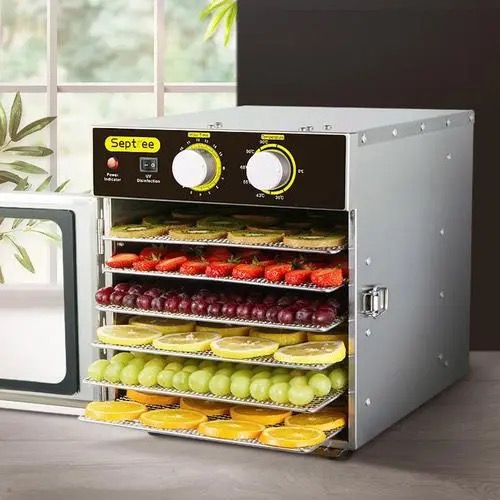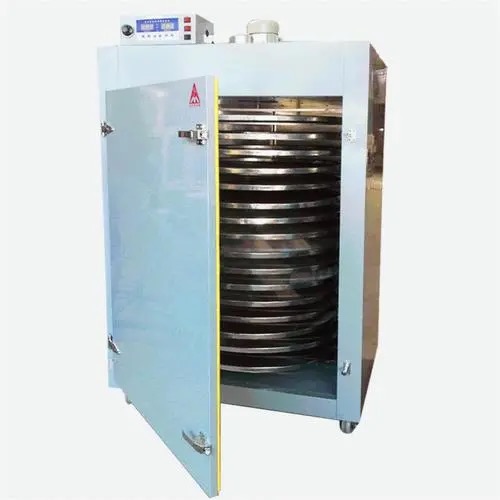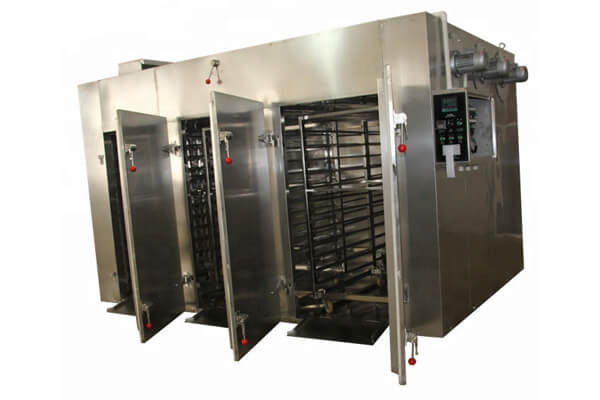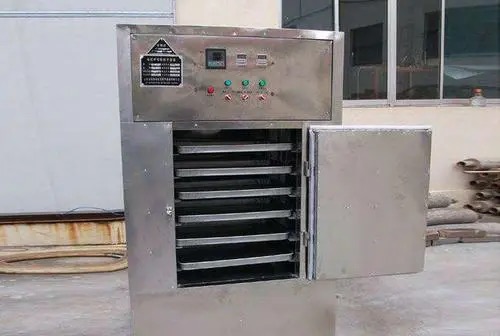
Content Menu
● Introduction
● Understanding Food Drying Oven Machines
>> Key Components of a Food Drying Oven Machine
● Types of Food Drying Oven Machines
>> 1. Conveyor Belt Dryer
>> 2. Multi-layer Food Dryer
>> 3. Stainless Steel Drying Oven
● Applications in the Food Processing Industry
>> Fruit and Vegetable Drying
>> Meat and Fish Processing
>> Herb and Spice Drying
● Advancements in Food Drying Technology
>> Energy-Efficient Food Dehydration
>> Automated Drying Technology
>> Hybrid Drying Systems
● Choosing the Right Food Drying Oven Machine
● Maintenance and Care
● The Future of Food Drying Technology
● Conclusion
● Frequently Asked Questions
>> 1. What is the optimal temperature range for drying most fruits and vegetables?
>> 2. How long does the drying process usually take in an industrial food drying oven?
>> 3. Are food drying oven machines energy-efficient?
>> 4. How often should a food drying oven machine be cleaned?
>> 5. Can a food drying oven machine be used for non-food items?
Introduction
In today's fast-paced food processing industry, efficiency and quality are paramount. At the heart of many food preservation processes lies a crucial piece of equipment: the food drying oven machine. These industrial marvels have revolutionized the way we preserve and process food, offering unparalleled consistency and productivity. In this comprehensive guide, we'll explore the world of food drying oven machines, their applications, and the impact they're having on the food processing landscape.
Understanding Food Drying Oven Machines
Food drying oven machines, also known as industrial food dehydrators, are sophisticated pieces of equipment designed to remove moisture from various food products. These machines play a critical role in food preservation, extending shelf life, and creating new product possibilities. From fruits and vegetables to meats and herbs, food drying oven machines are versatile workhorses in any food processing facility.
Key Components of a Food Drying Oven Machine
1. Drying Chamber: The heart of the machine where food products are placed for dehydration.
2. Heating Elements: Responsible for generating the heat necessary for the drying process.
3. Air Circulation System: Ensures even distribution of heat and removal of moisture.
4. Control Panel: Allows operators to set and monitor temperature, humidity, and drying time.
5. Trays or Conveyor Belt: Holds the food products during the drying process.

Types of Food Drying Oven Machines
1. Conveyor Belt Dryer
Conveyor belt dryers are ideal for continuous, high-volume production. Food products are placed on a moving belt that passes through different temperature zones, ensuring consistent drying. These machines are perfect for large-scale operations processing fruits, vegetables, and even pet food.
2. Multi-layer Food Dryer
Multi-layer food dryers feature stacked trays that allow for efficient use of vertical space. These machines are versatile and can handle a variety of food products simultaneously. They're particularly useful for smaller batches or facilities with limited floor space.
3. Stainless Steel Drying Oven
Stainless steel drying ovens are prized for their durability and ease of cleaning. These food-grade machines are resistant to corrosion and can withstand rigorous sanitization processes, making them ideal for strict hygiene environments.
Applications in the Food Processing Industry
Fruit and Vegetable Drying
Commercial fruit drying machines and vegetable drying equipment have transformed the snack food industry. These machines can process large volumes of produce, creating dried fruits and vegetables that retain their flavor, color, and nutritional value. From apple chips to sun-dried tomatoes, the possibilities are endless.
Meat and Fish Processing
Food drying oven machines play a crucial role in producing jerky, biltong, and other dried meat products. The controlled environment ensures food safety while achieving the desired texture and flavor profile.
Herb and Spice Drying
For the herb and spice industry, precision drying is essential to preserve aromatic compounds and active ingredients. Food processing ovens designed for this purpose offer precise temperature and humidity control, resulting in high-quality dried herbs and spices.
Advancements in Food Drying Technology
Energy-Efficient Food Dehydration
As sustainability becomes increasingly important, manufacturers are developing energy-efficient food dehydration systems. These machines incorporate advanced insulation, heat recovery systems, and smart controls to minimize energy consumption without compromising on performance.
Automated Drying Technology
The integration of automation and IoT (Internet of Things) technology has revolutionized food drying processes. Modern food drying oven machines can be programmed to adjust drying parameters automatically based on the product being processed, ensuring consistent results with minimal human intervention.
Hybrid Drying Systems
Innovative hybrid drying systems combine different drying technologies to optimize the process for specific products. For example, a system might use both convection and microwave drying to reduce processing time and improve product quality.

Choosing the Right Food Drying Oven Machine
Selecting the appropriate food drying oven machine for your facility depends on several factors:
1. Production Volume: Consider your daily output requirements.
2. Product Variety: Ensure the machine can handle the range of products you process.
3. Space Constraints: Evaluate your available floor space and ceiling height.
4. Energy Efficiency: Look for machines with energy-saving features.
5. Automation Level: Determine how much automation you need in your process.
6. Regulatory Compliance: Ensure the machine meets food safety standards and regulations.
Maintenance and Care
Proper maintenance of food drying oven machines is crucial for longevity and consistent performance. Regular cleaning, inspection of heating elements and air circulation systems, and calibration of controls are essential tasks. Many manufacturers offer preventive maintenance programs to keep your equipment in top condition.
The Future of Food Drying Technology
The food drying industry continues to evolve, with ongoing research and development focused on improving efficiency, product quality, and sustainability. Some exciting areas of innovation include:
1. Advanced Sensor Technology: Real-time monitoring of product moisture content for precise drying.
2. AI-Driven Process Optimization: Machine learning algorithms that fine-tune drying parameters based on historical data.
3. Novel Drying Methods: Exploration of new techniques like ultrasonic drying or supercritical CO2 drying.
4. Sustainable Materials: Development of eco-friendly insulation and components for drying machines.
Conclusion
Food drying oven machines have become indispensable in the modern food processing industry. From small-scale operations to large factories, these versatile machines offer efficient, consistent, and high-quality food dehydration. As technology continues to advance, we can expect even more innovative solutions that will further revolutionize the way we preserve and process food.
Whether you're in the market for a new food drying oven machine or looking to optimize your existing processes, understanding the technology and its applications is crucial. By staying informed about the latest advancements and best practices, you can ensure that your food processing operation remains competitive and produces the highest quality dried food products.

Frequently Asked Questions
1. What is the optimal temperature range for drying most fruits and vegetables?
Answer: The optimal temperature range for drying most fruits and vegetables is typically between 125°F to 140°F (52°C to 60°C). However, this can vary depending on the specific product and desired outcome. Lower temperatures are often used for herbs and delicate fruits to preserve color and nutrients, while higher temperatures may be used for denser vegetables.
2. How long does the drying process usually take in an industrial food drying oven?
Answer: The drying time can vary significantly depending on the product, its initial moisture content, the desired final moisture content, and the drying method used. On average, it can take anywhere from 6 to 26 hours for most fruits and vegetables. Meats may take longer, sometimes up to 48 hours for proper dehydration.
3. Are food drying oven machines energy-efficient?
Answer: Modern food drying oven machines are designed with energy efficiency in mind. Many incorporate features such as improved insulation, heat recovery systems, and smart controls to minimize energy consumption. However, the overall efficiency can depend on the specific model, its size, and how it's operated. It's important to look for machines with energy-saving features and to optimize your drying processes for maximum efficiency.
4. How often should a food drying oven machine be cleaned?
Answer: Food drying oven machines should be cleaned after each use to maintain hygiene and prevent cross-contamination. A more thorough cleaning and sanitization should be performed weekly or bi-weekly, depending on usage. Always follow the manufacturer's guidelines for cleaning procedures and frequency.
5. Can a food drying oven machine be used for non-food items?
Answer: While food drying oven machines are primarily designed for food products, they can sometimes be used for non-food items that require controlled drying conditions. However, it's crucial to maintain separate machines for food and non-food applications to prevent any risk of contamination. Always consult with the manufacturer before using a food drying oven for non-food purposes to ensure it's appropriate and won't void any warranties.












